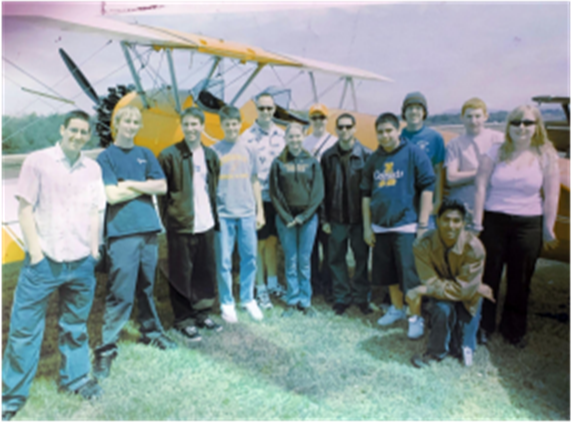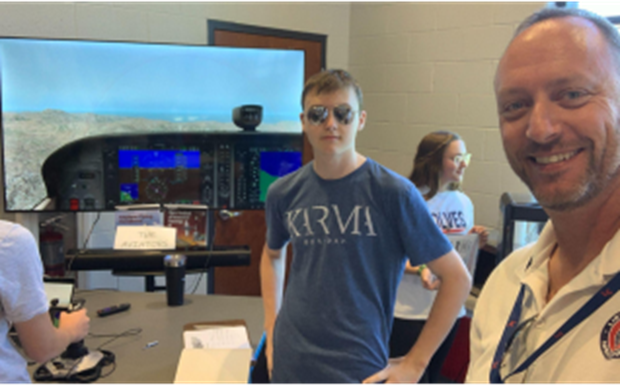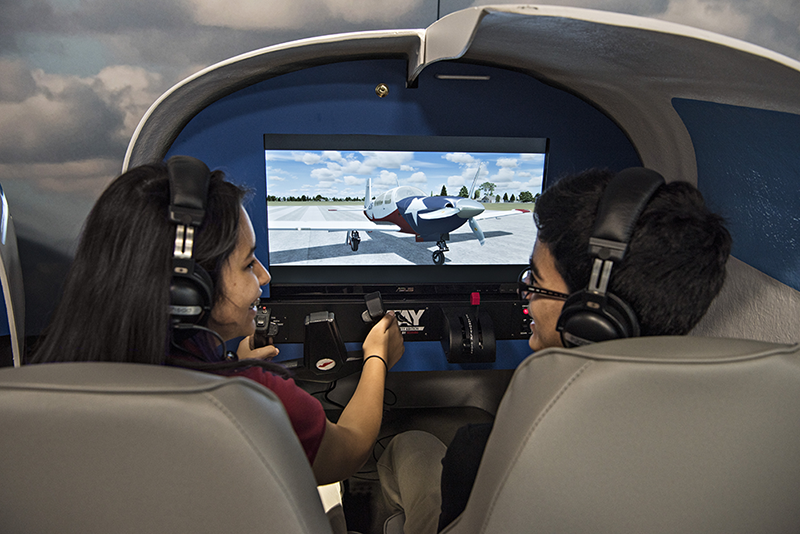How To Start a High School Aviation Club
Were you in a club in middle or high school? A vast array of clubs reside at most schools—from chess to drama clubs.
However, if you are Gen X or older, a quick search for clubs at your local high school today may raise an eyebrow and provoke jealousy. Fairly new to the list of common clubs is aviation club. Did you ever think you’d see an aviation club? If I had one at my school as a teenager, I would have been the club president!
During my career as a classroom teacher, I created two different aviation clubs. The first was at a high school in Southern California in 2006 and the second was at a high school in Middle Tennessee in 2022.
In 2006, I was teaching video production at the California high school and working as a flight instructor at the local flight school on the side. I loved aviation and imagined starting an aviation club for my high school students, but I didn’t have any experience starting or running a school club. So, I started slowly by putting out an interest sheet and mentioning the club during morning announcements.
Nine kids attended the first meeting! We talked a little about airplanes and the fact that I teach people how to fly. Students shared their backgrounds and discussed why they were interested in aviation. It was going well, so I turned on a flight simulator. Magic.
Hands-On Activities
I was fortunate to have a classroom with computers along the walls. I put Microsoft Flight Simulator X on one of them and brought in my personal flight yoke and rudder pedals.
I asked if any of them had ever flown on a simulator. One student raised his hand, so I asked him to sit at the computer and fly a final approach to our local airport. All the kids gathered tightly around the computer in awe as they watched one of their peers attempt to land safely.
The student brought the plane down to the runway pretty well, but he lost control after bouncing and plowing it on the runway. As you might expect from this age group, cheers and jeers erupted. Everyone seemed to be having fun, as evidenced by another student quickly asking if he could try the sim. That was the moment “The Aviators” flying club was born.
In the following weeks and months, we added more activities and topics to our club. I was the facilitator, but I encouraged the students to bring their wide variety of interests to our meetings. A student approached me and asked if I had ever flown radio-controlled airplanes. I told him that I had done it once and crashed it hard. He said that he did it all the time and was pretty good. He wanted to know if he could bring his airplane to the next meeting. Absolutely!
When the student showed up at the next meeting, he brought an impressively large RC plane styled as a powered sailplane. Once we were outside, he explained to the assembled group that he would hand-launch it and run the engine until the plane got to a suitable altitude where he would shut off the motor, retract the prop, and let it soar unpowered.
All the kids were in awe when he executed the procedure exactly as planned. So was I! The plane climbed quickly, and he flew it all over the campus with ease before bringing it back in and landing it smoothly in the grass. The kids were hooked.
Later, a student asked if we could mount his camera on the plane. I asked him to bring it to our next meeting. He had an action camera that looked more cylindrical than square. We discussed it, along with the weight, the placement of the camera on the body, the added drag, etc. The kids were learning about weight and balance through real-life hands-on experimentation, and they were excited about it.
We loaded a memory card into the camera and used strapping tape to secure it to the styrofoam body of the aircraft. The kids counted down for takeoff: 3, 2, 1... and the flight commenced.
Once we completed the flight, the kids couldn’t wait to come back to the classroom and watch a birds-eye video of the campus. Keep in mind that this was before drones were available. There was no other way to capture video over the campus other than with a real airplane or helicopter. It was amazing, and the kids were justifiably very proud of what they were able to accomplish.
Over time, the kids learned how to fly on what had become several flight simulators, and we evolved our sim setups. We were able to network the computers so we could all fly in the same airspace from our home airport to a nearby airport. Each week, we had a different flight to accomplish.
Field Trips
All this activity inevitably led to a field trip to our home airport. The father of one of our members flew traffic watch for AM640, KFI radio. He seemingly knew everyone in the local aviation scene, and with his connections, he helped get a cookout and flying day arranged for our club with a bunch of local pilots.
When we showed up, we were in awe at the aircraft our kids would soon be hopping in to go for a ride. On the ramp waited a Cessna 140, two 172s, three Stearman bi-planes, a Pilatus PC-12, and a Robinson 44 helicopter. The pilots met our club kids over lunch, and soon after, the rides began. Each student got a couple of rides in different aircraft. It was an amazing day that changed the lives of the kids.

The original Aviators Club in 2006 at the cookout and flying day at KAJO.
Of the 12 high school students in attendance that glorious day at KAJO, Corona, CA, six became certificated pilots, and one became a helicopter pilot who now flies professionally. Another currently works at ForeFlight.
After the cookout and flying day, we continued our exploration of aviation. We visited the local air museum and even got an air traffic control tower tour, which is no easy feat. Teenagers love food, so we would have lunch at the local airport cafe. Whatever I could think of that would spark interest in aviation, I tried with the club.
The club continued with a new group of students each year. About nine years later, we were able to start an official aviation program at the school with classes during the school day. The foundation of that class started with the club.
Recruitment and Promotion
In 2021, my family and I moved to an area just outside of Nashville, TN, and I started a new aviation program at a brand-new school. The school district didn’t have aviation at all prior to my arrival. After about three weeks of classes, I started the club. The school hosted a club rush, an event where all the clubs on campus show up in the cafeteria during lunchtime to promote. I knew a flight simulator had to be present to generate interest.
I connected my laptop to a 70-inch TV screen, and I had kids come in and try to land the plane at Catalina Island (KAVX). Kids were in a line, waiting for their turn. If they were interested in joining the club, they took a simple application that helped me identify why they were interested in joining the club. I also brought a small drone to float in the air to attract students to our area. It was a hit.

A student helps run the sign-up table at club rush, complete with aviator sunglasses.
A few of my student leaders from the class headed up the club to help get it running. To continue generating excitement for the club and our aviation program, I wanted a flashy way to let students know they had “made” the club. I created realistic-looking boarding passes with their names on them. The destination on the pass was my classroom, and the departure date and time reflected their first meeting as members.
I had my leaders deliver the passes during the school day to individual classrooms. What happens when someone comes to a classroom with something to give to another student? Everyone turns to check out what was given to the student. The receiving student would beam and proudly show the people around them the boarding pass. It created grand excitement.

New Aviators Club students show off their boarding passes.
During our first few meetings, kids expressed their interests, which consisted of learning how to fly, flying our simulators, flying drones, military aircraft, and airport visits. Here we go again! Everything developed just as I had hoped. The kids were excited, told their friends, more students showed up, and the club took off.
Our local airport had a pancake breakfast once a month, and I invited the club to show up to check it out. I was surprised at the turnout as kids and their parents showed up! That’s a big win. I knew right away that if I had the parents on board, building the club would be much easier.
I had a middle school student come up to me after school one day, stating that he had heard about the club. He wanted to know if he could join. I was surprised but also excited that he had heard about it and wanted to come. He said a couple of his friends were interested too. The boy was so polite that I said, “If the rest of them are like you, absolutely!”
At the next club meeting, he and five other middle school students showed up. Suddenly, I had seventh through twelfth graders in one classroom, voluntarily showing up for the aviation club after school.
Partnerships and Guest Speakers
We met once a week for 60-90 minutes. I usually organized a guest speaker to talk for the first half hour. I brought in other flight instructors, corporate and airline pilots, airplane owners, and retired military. I would arrange an interactive Zoom if I couldn’t get a speaker to be there in person. It gave the kids a chance to hear from someone other than me.
A few months later, the local EAA chapter visited our classroom for its monthly meeting. Club kids hosted the chapter with snacks, cookies, and drinks. My club kids set up EAA members on our flight simulators for test flights. The interaction was great, and it prompted our local chapter to set up EAA Young Eagle flights for our students a few months later. Parents and kids showed up, and it was a huge success.
In the months that followed, the Young Eagles flights were paired up with the monthly pancake breakfasts. Some of my club members showed up to help set up and/or clean afterward. In the end, it was a great win-win for all of us.
Growing With the Times
Drones are another area that we were able to explore with the club. I had a variety of drones for my program, and the club gave the kids an opportunity to try them out. One student, a senior, was already a drone expert. He built his own FPV drone and was extremely proficient.
He asked if he could bring his drone to the club. It reminded me of nearly 16 years earlier when a student asked if he could bring his radio-controlled motor glider. It was the same idea with far different technology, but the motivational effect was the same.
It was exciting to see what he could do with his FPV drone. He even taught a lesson on each item he bought, the costs, and how he assembled the final product. Most kids didn’t realize they could build their own. They saw our pricey DJI and other drones and assumed that buying one already built was the only way to get one. Much to their delight, they discovered that owning and operating a drone really was within their grasp.
I also had an eighth-grade student ask me if I was familiar with VATSIM. I was not. It is live air traffic control for simulator pilots, allowing them to fly in the same airspace and talk with a controller in real-time. This student then asked if he could show me. “Sure,” I said.
The student, all of 13 or 14 years old, quickly installed and set up VATSIM on our sim. He logged in and started a flight complete with air traffic control, at which point, he started communicating with ATC using proper phraseology!
The student was teaching the teacher. He told me that he often serves as the air traffic controller for a given area. If I didn’t allow middle school students into the club, I wouldn’t have met this student. I benefited, and the rest of my students then and into the future benefited. Everyone.
The Bottom Line
Starting an aviation club is a spectacular way to capture interest and drive the excitement of aviation for kids. It can become a predecessor to a full class with a curriculum. It can also be a great supplement to your classroom program.
A club is an excellent option for students who can’t take the class during the day due to scheduling. It affords extra time to cover additional topics or dig deeper into a given topic than the time allowed in a typical class. It is also great for kids in the class to get extra time around aviation.
Share this
You May Also Like
These Related Articles

Four Awesome STEM Programs Powered by Aviation

STEM Spotlight: Lone Star Flight Museum
